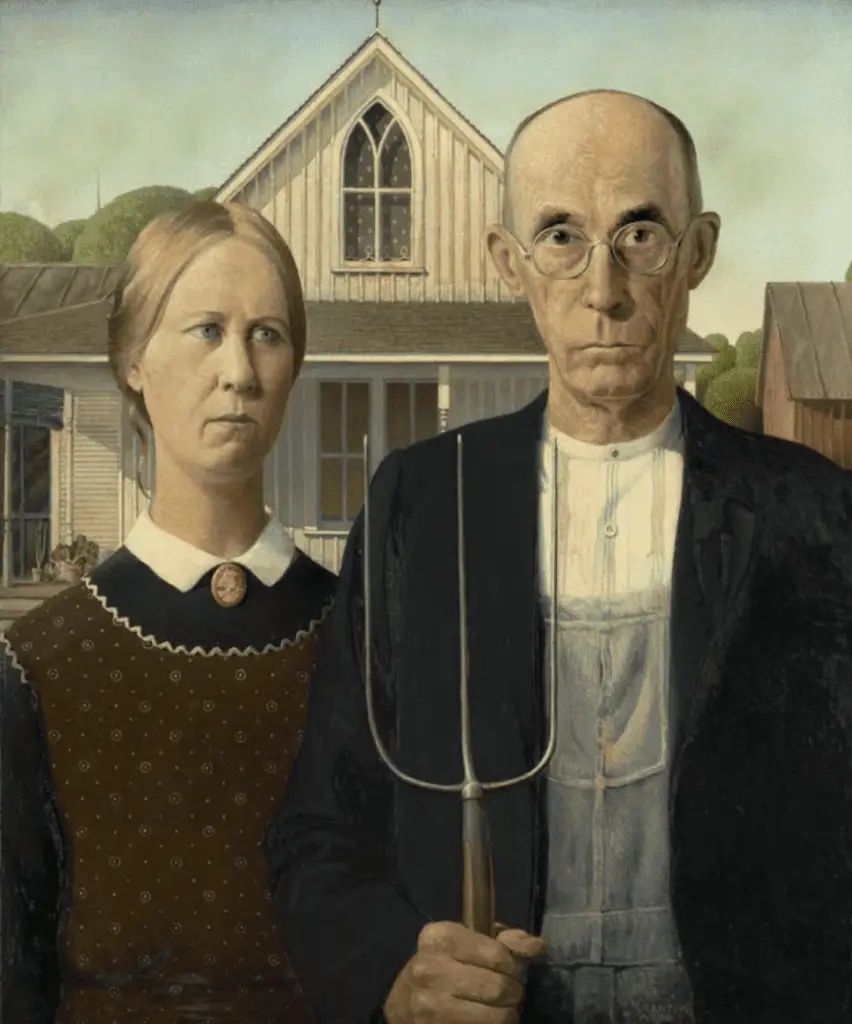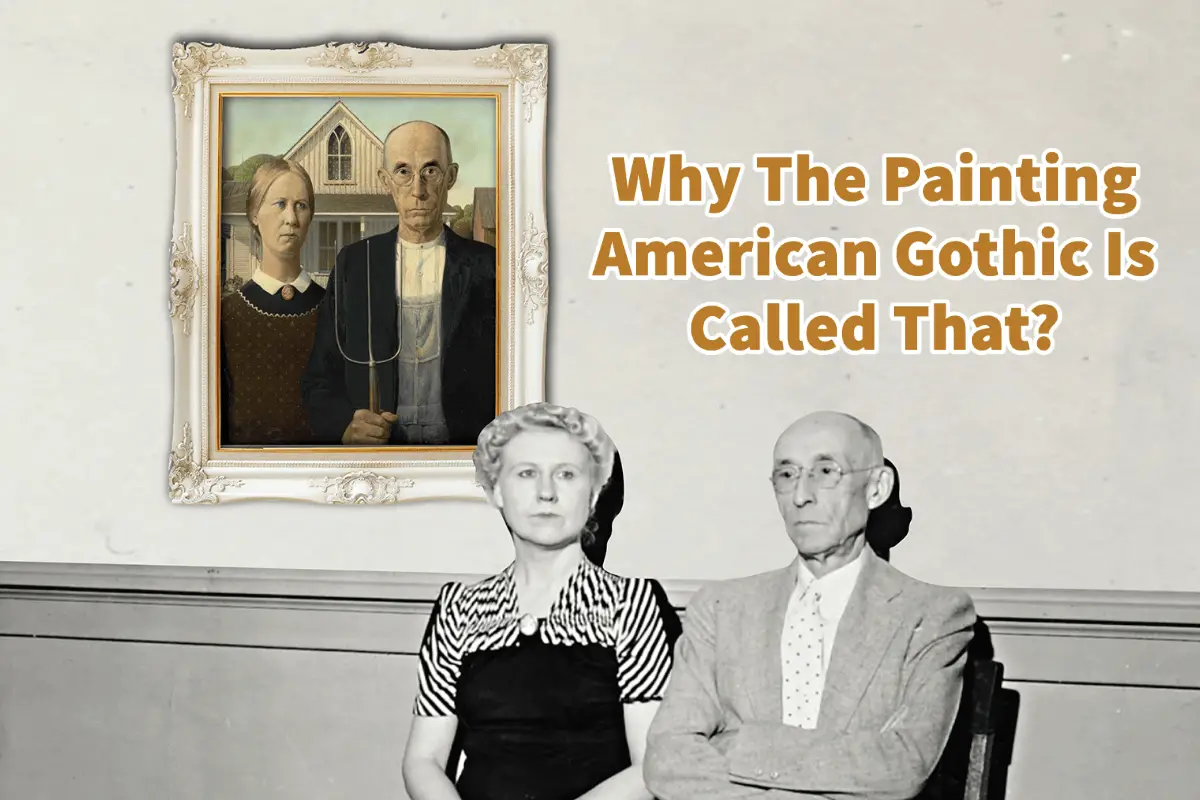One of America’s most iconic paintings is Grant Woods’ 1930s American Gothic. This painting is perhaps one of the most famous American paintings.
The American Gothic painting is named after the gothic-style windows Grant Wood found on a small house in Eldon, Iowa. To him, these gothic-style windows seemed out of place for such a small house in a rural setting; gothic windows were usually reserved for churches.
Table of Contents
- Why The Painting Is Called American Gothic
- About The American Gothic Painting
- Frequently Asked Questions
- Related Questions
Why The Painting Is Called American Gothic
Grant Wood (1891 -1942), the iconic American Gothic painting artist, rarely explained his work and did not clarify much about the painting. But we do know that this painting is based on an actual house in Eldon, Iowa.
He calls his painting American Gothic as the original house with Gothic-style windows. Today, you can visit Eldon, Iowa, and see the American Gothic house known as the Dibble House. The original portion of the house contains two Gothic windows. One is at the front, and one is at the back. This house was initially built from 1881 to 1882 by Catherine and Charles Dibble.
Facts About the American Gothic House
Here is what we do know about this famous American Gothic house:
- The original portion of the American Gothic house contains two Gothic windows. One is at the front, and one is at the back. This house was initially built from 1881 to 1882 by Catherine and Charles Dibble.
- In the summer of 1930, this famous house was seen by Grant Wood. when he was visiting there for an art exhibition in Eldon. The art exhibition was arranged by Edward Rowan, the Director of a Cedar Rapids art gallery. Rowan believed that art should be taken to remote areas, so he brought some art and artists to the small town of Eldon, Iowa.
- During his visit, Grant Wood spotted this tiny house with Gothic windows. When he saw the house, he asked the car it was in to stop so that he could make a sketch of the house.
- A year later, when Grant Wood was asked why he was so fascinated with the house, he said he found the Gothic-style windows so amusing and pretentious for such a small house.
- We know that the gothic-style windows on this tiny house were what caught Grant Wood’s eye and inspired his painting.
- We do not know why Catherine and Charles Dibble chose to have gothic-style windows on the 2nd floor of their home; a gothic-style window was more closely associated with a church than a home, especially such a small home in rural Iowa.
- It is believed the gothic-style windows were purchased from the Sears Roebuck catalog.
The name for the American Gothic came from the window styles on this small Dibble House in Eldon, Iowa. Grant Woods found the windows very pretentious and almost comical.
We know that Woods wanted to do a painting or portrait of Midwestern” types” of people he saw. This pretentious little house and the windows caught his attention for this painting and inspired him to paint the American Gothic painting.
The gothic-style windows of the original house and the paintings are not the same. Woods sketched the house on-site and then went back to his studio to paint the final painting.
About The American Gothic Painting

Grant Wood is the American painter of the American Gothic (1930). He is an artist who represents regionalism, and his painting of the American Gothic has become an iconic example of 20th-century American Art.
Grant Wood Add Elements In His American Gothic Painting
Many feel that his painting of the American Gothic was realistic, but the truth is that it was not, as Grant Wood added elements to the painting:
Here are some of the changes that he made.
- The man and woman being placed in front of their house were based on the concept that traveling photographers used in the late 19th and early 20th century; the photographer would often place the subjects in front of their homes to photograph them. The man and woman in this painting did not own this house, nor were they even associated with this house in any way.
- The painting has a barn in the picture, but the original house has no barn. Woods added the barn to possibly give the feel that the house was a farm.
- The two models for the painting were his dentist Dr. B.H. Mc Keeby and his sister Nan Wood Graham. When you look at a photo of Nan, you can see that Wood purposely elongated her face.
- The two models never sat together or stood together for the painting, but they were painted separately.
We know that Woods did not do anything haphazardly in this painting. Every detail was thought out as to its significance—everything from the pitchfork to the clothes they were wearing.
Upon closer examination, you can see that Woods repeated many patterns in the paintings. From the pitchfork shape repeated in the man’s overalls to repeat patterns on the house and the curtains.
Another aspect of the painting that many people wonder about is why the husband and wife in the American Gothic painting are not smiling, and they seem to be so serious and almost ill-humored. Their expressions would not have been too different from many of the photographs taken during this time. The photographer would usually encourage people not to smile because, at the time, the camera film had a long exposure time frame.
The American Gothic remains one of the most iconic paintings of the 20th Century. It is a painting that shows us a glimpse into American midwestern life.
Frequently Asked Questions
Why is the painting called “American Gothic”?
The painting is named after the gothic-style windows that artist Grant Wood observed on a small house in Eldon, Iowa. These windows played a significant role in inspiring the title of the artwork.
What is the significance of the gothic-style windows in American Gothic?
Grant Wood was drawn to the gothic-style windows because he found them unusual and out of place for the small house in rural America. These windows became a distinctive feature in the painting, contributing to its overall theme.
How did the gothic-style windows influence Grant Wood’s artistic choice?
The gothic-style windows served as a visual focal point for Wood, influencing the composition of the painting and contributing to the overall atmosphere. They became a key element in defining the character and style of the artwork.
Were there specific reasons why Grant Wood chose Eldon, Iowa, for the American Gothic setting?
Grant Wood selected Eldon, Iowa, as the setting for American Gothic because of the small house with the gothic-style windows. The unique and unexpected presence of these windows in a rural context captured his imagination and became the foundation for the painting.
Did Grant Wood provide any commentary on the choice of the gothic-style windows in American Gothic?
While Wood did not explicitly explain the choice of the gothic-style windows, their inclusion in the painting is often interpreted as a commentary on the clash between traditional and modern elements in American society during the 1930s.
How did the American Gothic painting contribute to the portrayal of rural America during the 1930s?
American Gothic is considered a quintessential representation of rural America during the 1930s. The choice of the gothic-style windows symbolizes the complexities and contrasts within American society during that period.
Were there any controversies surrounding the naming of the painting “American Gothic”?
There were no major controversies surrounding the naming of the painting. Grant Wood himself provided insight into the inspiration behind the title, attributing it to the distinctive gothic-style windows he observed in Eldon, Iowa.
Did Grant Wood receive feedback or criticism for his choice of the gothic-style windows in American Gothic?
While opinions on art are subjective, there is no significant record of widespread criticism regarding Wood’s choice of the gothic-style windows. Instead, the painting is celebrated for its unique portrayal of American life.
How did the gothic-style windows contribute to the overall symbolism of American Gothic?
The gothic-style windows can be seen as symbolic elements representing a blend of traditional and perhaps even European influences within the American landscape. Their inclusion adds depth to the narrative of the painting.
Is there any additional meaning or interpretation associated with the gothic-style windows in American Gothic?
While the primary association is with the architectural features, some art historians and critics suggest that the gothic-style windows may also symbolize the tension between urban and rural values, providing a nuanced layer of meaning to the painting.
Anita Louise Art is dedicated to art education, great artists, and inspiring others to find and create their art. We love art that uplifts and inspires. #ArtToMakeYouSmile! #ArtToMakeYouHappy!
If you want to see any of my art, you can find out more by clicking here. If you are interested in what inspires me and my paintings, you can discover more by clicking here.
We have a free newsletter and would love you to be part of our community; you can subscribe to the newsletter by clicking here. If you have any questions, I would be happy to talk to you anytime. You can reach me, Anita, by clicking here.
Subscribe to our Anita Louise Art YouTube Channel with great videos and information by clicking here.
Join us for our podcast “5 Minutes With Art.” Spend just 5 minutes a week with us to discover and learn about great art and artists. You can find out more about our podcast by clicking here.
Related Questions
How Was Leonardo da Vinci Able To Master So Many Different Professions?
Leonardo da Vinci is a man known to have had many different titles and professions during his lifetime. He was able to master this profession because he was a genius. But more than just being a genius, Leonardo is also self-educating and never stops learning. He had an insatiable amount of curiosity about all kinds of subjects.
By clicking here, you can learn more by reading How Was Leonardo da Vinci Able To Master So Many Different Professions?.
Was Leonardo da Vinci A Philosopher?
Leonardo da Vinci was a philosopher; being a philosopher means that you want to seek wisdom. Leonardo was one person who wanted to seek wisdom or enlightenment in his life. Leonardo was an active observer and learner of the human body, human behavior, and nature.
By clicking here, you can learn more by reading Was Leonardo da Vinci A Philosopher?.

